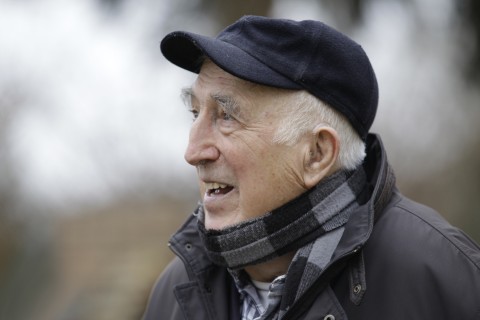Jean Vanier and the gift of L’Arche
Vanier found fullness of life in those snatched from despair and placed in homes based on mutuality, respect, and care.

When Jean Vanier entered the room, it was buzzing with grace. It was as if the air was buoyed in warmth. Across the room, sensing the presence of someone holy, our friends and housemates—L’Arche “core members,” people with intellectual disabilities—turned their faces toward the gentle giant with a broad steady smile and tufts of white hair. He had a slight bend to his back, as if his posture had adjusted over time to look into the faces of those smaller than him, which was almost everyone.
I met Vanier, who died May 7, on one of his last trips to the United States. He came to the gathering of L’Arche communities in the Pacific Northwest. My community in Portland had grown from the experiment in gentle reception that was birthed in 1964, when Vanier sensed a call from God to live among the poor.
Vanier first learned about the possibilities of intentional community while visiting Harlem in the 1940s. It was there he met the people of Friendship House—an experiment in cross-racial living, founded by Catholics, that was being taken up around the US and Canada. He saw similar work happening among the people who lived in the Catholic Worker homes in New York.
Vanier returned to France after teaching philosophy in Toronto and serving in the Royal Navy during World War II. A local priest took him to an institution in Trosly called Val Fleury, where he saw people with profound disabilities treated as refuse. Here are the poor, the priest told him.
In 1964 Vanier invited two men, Raphael Simi and Philippe Seux, to leave the institution and live with him in a house in Trosly. This was the first L’Arche community.
It did not take long for the community to grow. “On the edge of the forest of Compiègne, L’Arche has opened its first home for the mentally and physically handicapped,” Vanier wrote in his earliest diary entries about L’Arche. “These family-like homes, each welcoming from four to nine boys, at least twenty years old, are lifelong homes. They are the first of a group of homes which will be linked together with workshops, a cultural centre, a chapel and the necessary medical help.”
L’Arche sparked hope not only for people with intellectual disabilities but for a new way of ordering life for everyone. L’Arche communities arose around the world—in Uganda and the West Bank, in France and Washington, D.C., in Japan and Egypt.
Vanier offered the gift of L’Arche to the world through his writings, opening a window to the communities of L’Arche International. Some of his reflections appear in his book The Gospel of John, the Gospel of Relationship. In 2008 Vanier reflected on L’Arche and nonviolence with theologian Stanley Hauerwas in their book Living Gently in a Violent World. But the best-known book, often called the L’Arche bible, is Community and Growth, a series of reflections that continues to form intentional communities throughout the world—communities that seek to live the charism of friendship discovered in L’Arche.
Many people know about L’Arche through the writings of author and theologian Henri Nouwen. Vanier struck up a friendship with Nouwen after the two met at Harvard. Vanier sensed a loneliness in Nouwen and invited him to spend time with the people of Trosly. This visit led Nouwen to leave his position at Harvard and become pastor of L’Arche Daybreak in Toronto. (Nouwen recorded his experience in The Road to Daybreak.)
L’Arche grew by way of invitations like these, because the people who visit L’Arche homes sense God in the slow and gentle rhythms of the community, in the dismantling of violence and self-protection that comes when life orbits around the most vulnerable. This activity, Vanier reminded us, was not a burden but a wellspring of joy.
In 2003 Vanier was awarded the Peace and Freedom Award of the Pacem in Terris Coalition. In his speech he remarked that some in the world have witnessed to peace through heroic acts of deprivation or martyrdom. “How is it you turn to us?” he wondered.
You see, we are not very austere or stressed, struggling to be heroes. We eat wonderfully, we drink merrily—of course Coca-Cola, orange juice and, now again, wine and beer, moderately—we sing loudly and frequently out of tune, and we dance wildly and we play as much as possible. Feast days, birthdays are all occasions for parties and for fun. . . . The heart of L’Arche is to rejoice and to celebrate unity. We would like to be little signs of the kingdom of God, the kingdom of love.
Vanier came looking for Jesus in the neglected. He found fullness of life in communities based on mutuality, respect, and care. As a doctor of philosophy, a member of the Royal Navy, a published author and professor, Vanier knew the patterns of success and advancement. But he discovered true life in relationships that offered to undo our desires for power.
When Vanier visited a local community he offered each person a chance to meet him for a short talk and a blessing. But he was drawn to L’Arche core members in a special way, as if seeing a beautiful flower for the first time, or encountering a gem unearthed from the ground. He wanted to see each of them, to let them touch his face, to sit in the stillness of time that L’Arche makes possible. Vanier made it possible to believe that we might be transformed by the gentleness of love.
A version of this article appears in the print edition under the title “Vulnerable at the core.” The online version was edited May 17.






